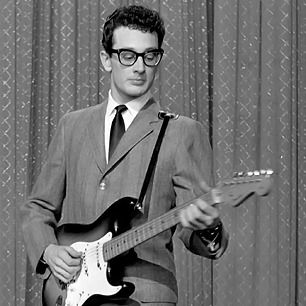http://www.thisdayinmusic.com/pages/...the_music_died
The Day The Music Died
On 3rd Feb 1959, 22-year-old Buddy Holly, the Big Bopper, and Ritchie Valens, aged 17, died in a plane crash shortly after takeoff from Clear Lake, Iowa. The pilot of the single-engine Beechcraft Bonanza was also killed. Holly hired the plane after heating problems developed on his tour bus. All three were traveling to Fargo, North Dakota, for the next show on their Winter Dance Party Tour which Holly had planned to make money after the break-up of his band, The Crickets, in the previous year.
The Winter Dance Party Tour was planned to cover 24 cities in just three weeks and Holly would be the biggest headliner. Waylon Jennings, a friend from Lubbock, Texas, and Tommy Allsup joined the tour as backup musicians. Ritchie Valens, probably the hottest of the artists at the time, The Big Bopper, and Dion and the Belmonts made up the list of other performers.
The grueling tour schedule had taken the acts to the Surf Ballroom in Clear Lake, Iowa the previous night. Due to mechanical difficulty with their chartered bus, the group arrived at Surf Ballroom less than two hours before the performance. The ballroom was packed with over 1500 fans, many of whom had driven hundreds of miles on snow-covered roads to see the stars perform.
Buddy was fed up with the chartered bus with its faulty heater, so before the performance he asked the Surf manager Carroll Anderson about renting a chartered plane to fly him to his next destination in Moorhead, Minnesota. Anderson knew the owner of Dwyer Flying Service in nearby Mason City whom he contacted to arrange the flight. Anderson was not able to get hold of the owner so he called one of the pilots, Roger Peterson, who agreed to take Buddy plus two others to Moorhead.

After the performance, the group got ready to travel to their next show on the tour bus. Holly boarded the 1947 Beechcraft Bonanza aircraft to Fargo, North Dakota, the nearest airport to Moorhead. Two other members of the group had the option to fly with him at $36 per person. Dion didn’t want to pay, but Waylon Jennings was keen to fly with Buddy, but exchanged his seat with J.P. Richardson because he had a cold. Tommy Allsup was included in the group, but Ritchie Valens offered to flip him for the seat since he was ill. The local host of the Winter Dance Party, Bob Hale, flipped the coin. Ritchie called heads and won the toss. Years later, Tommy Alsup would open a dance club named the Heads Up Saloon to commemorate this life-saving coin toss.
Right before the plane took off, Buddy Holly said to Waylon Jennings " I hope your bus crashes ". In his 1996 autobiography, Waylon Jennings stated that he was disappointed that he had to ride in the freezing bus, so his parting remark to Buddy was, "I hope your damn plane crashes!" Jennings said this remark has haunted him ever since then.
The plane took off around 1:00 AM from Mason City Airport into a blinding snowstorm and crashed only minutes later in a cornfield, killing all three musicians and the pilot. Because the plane didn't catch fire when it crashed, no one noticed the wreckage until the next day, about a quarter mile from the nearest country road.
In 1988, Buddy fan Ken Paquette built a monument to the singers, from stainless steel, and placed it at the crash site where the current owners of the land also planted four trees in memory of the victims.
Holly is often described as the most influential of the early rock and roll musicians, and has been cited as such by John Lennon and Paul McCartney (McCartney owns the publishing rights to Holly's catalog of songs). The death of Holly is now commonly referred to as "the day the music died" after Don McLean immortalised the tragedy with his 1972 hit “American Pie.” McLean has stated that he first learned about Buddy Holly's death while delivering newspapers on the morning of February 3, 1959, and in his song uses the line, "February made me shiver/with every paper I'd deliver."
